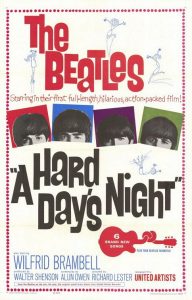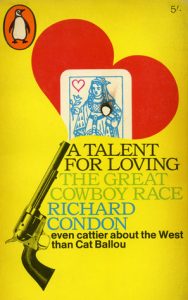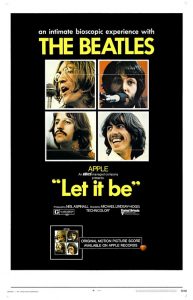The Beatles Movies That Never Happened
Once upon a time…or maybe twice…and on a personal note…I’ve been a Beatles fan as long as I can remember. Similarly, I’ve been a movie fanatic for almost as long (though not quite). So, at some point, I naturally started thinking about my favorite Beatle movie moments. Then, I started to ponder the moments that never actually happened. Now, I’m not suggesting that I was lost in some sort of drug-induced Sixties flashback, but rather I was thinking about the several unrealized film projects that the band never actually made.
Sure, A Hard Day’s Night (1964) is fantastic; Help! (1965) has its own unique charm by spoofing the then “new” James Bond style spy film; Yellow Submarine (1968) is sublime in its ground-breaking animated whimsy; and, finally, Magical Mystery Tour (1967) and Let It Be (1970) are pretty darn good celluloid time capsules. But, wouldn’t it have been interesting to have seen a version of The Lord of the Rings starring the Beatles (especially given the involvement of director Peter Jackson in the current revisioning of the “Let It Be” project…more on that later)? That’s just one of the many film projects that were rejected by the band that could cause even the most casual Beatle fan to wonder what might have been.
The Heyday of Beatlemania on Film

Prior to the initial wave of American Beatlemania back in the early 1960s, The Beatles’ manager, Brian Epstein, signed the band to a three-picture contract with United Artists. A Hard Day’s Night and Help! quickly fulfilled two-thirds of their obligation. Following the critical (at least in the case of A Hard Day’s Night) and commercial success of these two films, Walter Shenson, the producer of both films, began looking for a third property to showcase the Fab Four.
Several projects were considered, announced, and ultimately abandoned. Among the several un-produced Beatle film projects were ideas ranging from the wistful (A Talent for Loving), the silly (The Three Musketeers), the absurd (The Lord of the Rings), the avant-garde (Shades of a Personality), and the just plain weird (Up Against It). It is Joe Orton’s Up Against It that proves particularly intriguing. This never-was Beatle film’s tragic history, gifted yet cursed author, and rather bizarre themes and motifs (that seemed specifically designed to shatter the wholesome Beatle image), make it a fascinating footnote in the history of the band (and their filmic endeavors).

The first proposed third film was titled A Talent for Loving. Based on the novel by Richard Condon (who had previously penned The Manchurian Candidate [1962]), the film was supposed to follow four Liverpudlian pioneers in the Old West, include a harrowing horse race across the country, and the affections of a well-to-do (and presumably beautiful) young woman. Even though A Talent for Loving was officially announced as the Beatles next film in early 1965, by June, the film had been abandoned and the search for a third project carried on. That film would later be fashioned into a vehicle for Richard Widmark and Topol called Gun Crazy (1969).
Other projects were suggested, including The Lord of the Rings and The Three Musketeers, and ultimately rejected. A collaboration with Walt Disney on the animated film The Jungle Book was also discussed around this time. It was hoped that The Beatles would record the music and even make a brief appearance in the film. John Lennon was vehemently opposed to the idea and refused to even consider the possibility. Lennon, however, had been championing a Lord of the Rings project (he planned on playing Gollum with Paul McCartney as Frodo, George Harrison as Gandalf, and Ringo Starr as Frodo’s confidant Sam). That project was ultimately shelved when the film rights were refused by the J.R.R. Tolkien estate. But it’s certainly intriguing to think about what a Beatles version of Tolkien’s epic drama might have looked like with 1960s-era special effects and the influence of the burgeoning “hippie” sensibility (if films like Barbarella [1968] are any indication, it is perhaps best that the project died).

Is it possible that The Beatles could have played these four vultures had “The Jungle Book” project with Walt Disney gone forward?
In retrospect, the comedic Three Musketeers seems the more natural, as well as logical, choice for a third Beatles film project (although the physical comedy the production would have demanded might have proven difficult—or perhaps too costly for insurance purposes—for them). But, since The Beatles had, by this time, outgrown the mop-top image of their earlier films and were no longer interested in simply playing themselves, the film was scrapped. (Richard Lester, who had directed the first two Beatle films, would go on to enjoy great success directing a series of “Musketeer” movies made in much the same vein as the one proposed to The Beatles.)
At this point it was obvious that The Beatles had no desire to play such a homogenized filmic version of themselves. Indeed, to do so would have amounted to little more than self-parody as well as resulted in cheapening the artistic achievements of their first two films. The Beatles were well aware of the cookie-cutter approach to movies that Elvis Presley had taken and were adamant that they wouldn’t follow the same path and continued to look for a bold, new film project that would complement their new musical directions and burgeoning individual personalities.
Beatles 3 and Up Against It
Consequently, Shenson continued his search for a third film for The Beatles aware that they would more than likely reject anything that remotely resembled their two earlier films. In fact, as Roy Carr recounts in The Beatles at the Movies (New York: HarperPerennial, 1996), Shenson went so far as to announce in late 1966 that the Beatles next film would feature The Beatles playing not The Beatles but rather “four characters who look, think and talk like The Beatles but are [in fact] different characters.” “The only other criteria,” Shenson elaborated, “would be that any new Beatles movie would have to be contemporary. They don’t want to do a period story” (92). The script that successfully met Shenson’s somewhat contradictory requirements was originally given the unoriginal title Beatles 3 then later changed to Shades of a Personality. The film was written by Owen Holder and was to be directed by Michelangelo Antonioni (the influential maker of Blow-Up [1966]) as stalwart Lester was unavailable due to scheduling conflicts.
The rather bizarre and confusing plot of the new film was centered around a character (played by one of The Beatles) who suffers from a three-way split personality (three characters the remaining Beatles would portray). Unfortunately, additional schedule conflicts and Shenson’s belief that the script wasn’t quite good enough forced a continued search for a “quality” writer. Eventually, according to Philip Norman in Shout!: The Beatles in Their Generation (New York: Fireside, 1981), “a script was commissioned from Joe Orton, the young, working-class dramatist whose macabre comedies, Loot and Entertaining Mr. Sloane, had each been huge West End successes” (278).
Orton fashioned Shades of a Personality into Up Against It by taking the original premise and combining it with his earlier (The Silver Bucket) and current projects (The Vision of Gombold Proval). The script, as described by Orton himself in The Beatles at the Movies, contained “political assassination, guerrilla warfare, and tranvestism” and called for the group to “have been caught in-flagrant, become involved in dubious political activity, dressed as women, committed murder, been put in prison, and committed adultery” (133). Orton completed his script at the end of February 1967. It was returned to him in early April without explanation.
It is easy to understand why Orton’s script was rejected. The Beatles’ public image was still under the dogged control of manager Brian Epstein and Up Against It would definitely have hurt that image. Paul McCartney, according to Carr, was more candid with the reason The Beatles had rejected the script: “The reason why we didn’t do Up Against It wasn’t because it was too far out or anything like that. We didn’t do it because it was gay. We weren’t gay and really that was all there was to it. It was quite simple, really. Brian was gay, and so he and the gay crowd could appreciate it. Now, it wasn’t that we were anti-gay—just that we, The Beatles, weren’t gay” (135). However, if The Beatles were indeed interested in completely shedding their mop-top image, then perhaps a project such as this would have been the perfect vehicle. Or, perhaps it could have had the adverse effect, a la The Monkees attempt to shed their pre-fabricated image with the surreal Head (1968).
The Search Continues…
It is more likely that The Beatles had merely had enough of making movies and wanted to focus on their personal lives as well as their music. It was during this time that the Yellow Submarine animated project eventually found momentum. This was a project The Beatles had initially agreed to believing it would fulfill their contractual obligation to United Artists. When it turned out that it would not, the band lost interest in the film. But the negative reaction to their self-made Magical Mystery Tour and the positive press Yellow Submarine garnered upon release quickly won them over (it would seem that The Beatles could occasionally be as collectively image conscious as their manager was).
Ultimately, the third film owed to United Artists would have to wait another two years. The story of Up Against It, however, ended tragically when it was discovered that Kenneth Halliwell, Orton’s lover, had savagely murdered the young playwright and then killed himself. In a bizarre twist of fate, Brian Epstein also died nine days later and the search for a third Beatles’ film project effectively ended.
The Beatles’ three-picture commitment to United Artists was finally met with the release of the documentary Let It Be in 1970. Ironically, the film culled from footage shot for the aborted “Get Back” project achieved what they had hoped a well-planned third film would have and effectively destroyed The Beatles mythos and allowed them to grow as artists and individuals.
Unfortunately, the group had already disintegrated and broken up by then and the freedom they might have enjoyed as The Beatles in subsequent film projects was never realized. It will be interesting to see if the aforementioned collaboration between The Beatles and Academy Award®-winning filmmaker Sir Peter Jackson on the revitalization of the often maligned “Let It Be” project provides a more fitting final coda on the celluloid career of the band.
Mike Tyrkus
Latest posts by Mike Tyrkus (see all)
- Box-Office Weekend: Black Phone Hangs Up Tron - October 24, 2025
- Box-Office Weekend: Taylor Swift is Queen - October 5, 2025
- Box-Office Weekend: One Battle After Another - September 28, 2025




